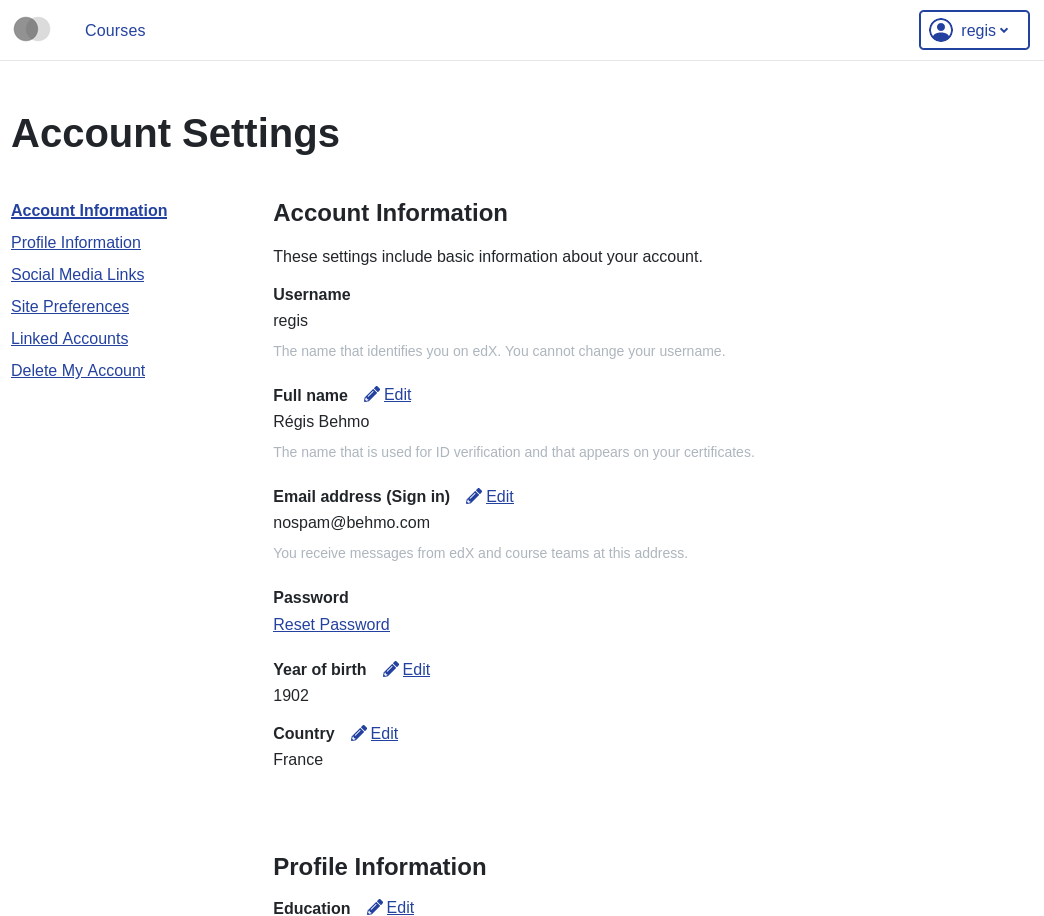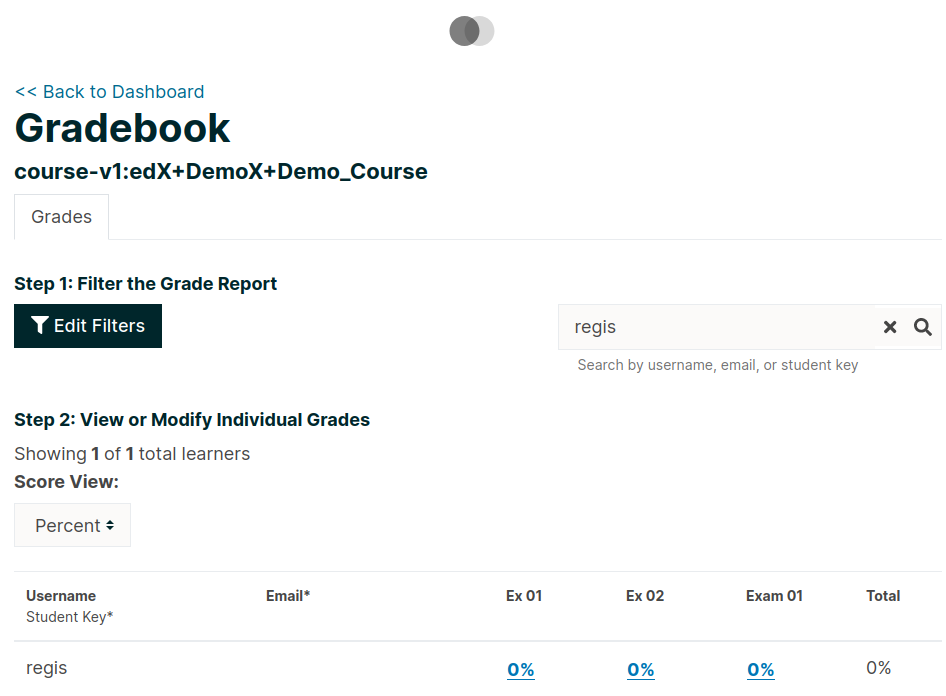Micro Frontend base plugin for Tutor
This plugin makes it possible to easily add micro frontend (MFE) applications on top of an Open edX platform that runs with Tutor. To learn more about MFEs, please check the official Open edX documentation.
In addition, this plugin comes with a few MFEs which are enabled by default:
Instructions for using each of these MFEs are given below.
pip install tutor-mfe
tutor plugins enable mfe tutor local quickstart
An MFE to manage account-specific information for every LMS user. Each user's account page is available at http(s)://{{ MFE_HOST }}/account. For instance, when running locally: https://apps.local.overhang.io/account.
This instructor-only MFE is for viewing individual and aggregated grade results for a course. To access this MFE, go to a course 🡒 🡒 Instructor tab 🡒 Student Admin 🡒 View gradebook. The URL should be: http(s)://{{ MFE_HOST }}/gradebook/{{ course ID }}. When running locally, the gradebook of the demo course is available at: http://apps.local.overhang.io/gradebook/course-v1:edX+DemoX+Demo_Course
The Learning MFE replaces the former courseware, which is the core part of the LMS where students follow courses.
Edit and display user-specific profile information. The profile page of every user is visible at http(s)://{{ MFE_HOST }}/profile/u/{{ username }}. For instance, when running locally, the profile page of the "admin" user is: http://apps.local.overhang.io/profile/u/admin.
Other Tutor plugin developers can take advantage of this plugin to deploy their own MFEs. To declare a new MFE, a new configuration setting should be created with the "_MFE_APP" suffix. This configuration setting should include the name, repository, development port and production/development settings for the MFE. For example:
config = {
"defaults": {
"MYMFE_MFE_APP": {
"name": "mymfe",
"repository": "https://github.com/myorg/mymfe",
"port": 2001,
"env": {
"production": {
"MY_CUSTOM_MFE_SETTING": "prod value"
},
"development": {
"MY_CUSTOM_MFE_SETTING": "dev value"
}
}
}
}
}
The MFE assets will then be bundled in the "mfe" Docker image and served at http(s)://{{ MFE_HOST }}/{{ MYMFE_MFE_APP["name"] }}. Developers are free to add extra template patches to their plugins, as usual: for instance LMS setting patches to make sure that the LMS correctly connects to the MFEs.
To disable an existing MFE, set its corresponding configuration setting to "null". For instance, to disable the MFEs that ship with this plugin:
tutor config save --set MFE_ACCOUNT_MFE_APP=null tutor config save --set MFE_GRADEBOOK_MFE_APP=null tutor config save --set MFE_PROFILE_MFE_APP=null
This plugin makes it possible to change existing and add new translation strings to MFEs. Here is how to do it:
Identify the ID of the string you would like to translate. For instance, the ID of the "Account Information" string in the account MFE is "account.settings.section.account.information" (see source).
Create a folder and i18n file corresponding to your MFE app and language in the Tutor root. This location of this file should be
/path/to/tutor/env/plugins/mfe/build/mfe/i18n/<app name>/<language code>.json. For instance, to add French ("fr") translation strings to the account MFE, run:cd "$(tutor config printroot)/env/plugins/mfe/build/mfe/i18n/" mkdir account touch account/fr.json
Add your entries to this file in JSON format, where the key is the string ID and the value is the actual string. For instance:
{ "account.settings.section.account.information": "Information du compte POUAC" }Rebuild the MFE image and restart the MFE with:
tutor images build mfe tutor local start -d
Your custom translation strings should now appear in your app.
To change the MFEs logos from the default to your own logos, override the corresponding settings in the MFEs environment using patches mfe-env-production and mfe-env-development. For example, using the following plugin:
name: mfe_branding_plugin
version: 0.1.0
patches:
mfe-env-development: |
LOGO_URL=<URL>/logo.svg
LOGO_TRADEMARK_URL=<URL>/logo-trademark.svg
LOGO_WHITE_URL=<URL>/logo-white.svg
FAVICON_URL=<URL>/favicon.ico
mfe-env-production: |
LOGO_URL=<URL>/logo.svg
LOGO_TRADEMARK_URL=<URL>/logo-trademark.svg
LOGO_WHITE_URL=<URL>/logo-white.svg
FAVICON_URL=<URL>/favicon.ico
To install custom components for the MFEs, such as the header and footer, override the components by adding a patch to mfe-dockerfile-post-npm-install in your plugin:
patches:
...
mfe-dockerfile-post-npm-install: |
# npm package
RUN npm install '@edx/frontend-component-header@npm:@edx/frontend-component-header-edx@latest'
# git repository
RUN npm install '@edx/frontend-component-footer@git+https://github.com/edx/frontend-component-header-edx.git'
The same applies to installing a custom brand package:
patches:
...
mfe-dockerfile-post-npm-install: |
RUN npm install '@edx/brand@git+https://github.com/edx/brand-edx.org.git'
In case you need to install components from a private NPM registry, you can append the --registry option to your install statement or add a npm config set command to the plugin.
In some cases, for example when using GitLab's NPM package registry, you might also need to provide a token for your registry, which can be done with an additional npm config set command as well:
patches:
...
mfe-dockerfile-post-npm-install: |
RUN npm config set @foo:registry https://gitlab.example.com/api/v4/projects/<your_project_id>/packages/npm/
RUN npm config set '//gitlab.example.com/api/v4/projects/<your_project_id>/packages/npm/:_authToken' '<your_token>'
RUN npm install '@edx/frontend-component-header@npm:@foo/<your_frontend_component_header_name>@latest'
The MFE plugin works a bit differently than other Tutor plugins. MFEs are static bundles of js/html/css code that must be re-generated after every change to their configuration. In practice, this means that the "mfe" Docker image should be re-built and re-deployed every time we run tutor config save. This happens transparently when running Open edX locally (with tutor local). But when running on Kubernetes, you need to re-build the "mfe" image manually and push it to a remote registry. In effect, you must run:
tutor config save --set MFE_DOCKER_IMAGE=docker.io/yourusername/openedx-mfe:latest tutor images build mfe tutor images push mfe tutor k8s start
We consider that this situation is less than ideal. An improvement would be to self-host a Docker registry and an image-building pipeline on Kubernetes. If you are interested in such a solution, please let your voice be heard on the Tutor community forums.
Tutor makes it possible to run any MFE in development mode. For instance, to run the "profile" MFE:
tutor dev start profile
Then, access http://apps.local.overhang.io:1995/profile/u/YOURUSERNAME
You can also bind-mount your own fork of an MFE. For example:
cd /path/to/frontend-app-profile npm install # Ensure NPM requirements are installed into your fork. tutor dev start --mount=. profile
The changes you make to your fork will be automatically picked up and hot-reloaded by your development server.
This works for custom MFEs, as well. For example, if you added your own MFE named frontend-app-myapp, then you can bind-mount it like so:
cd /path/to/frontend-app-myapp npm install tutor dev start --mount=. myapp
However, if you try to bind-mount an unknown MFE, you will see a Docker Compose error such as:
ERROR: The Compose file is invalid because: Service myapp has neither an image nor a build context specified. At least one must be provided.
Please note that bind-mounting a fork is only available for development (tutor dev ...), since production MFEs are compiled and served out of a single container. If you want to use a fork of an MFE in production, then you will need to set the repository URL in $(tutor config printroot)/config.yml:
MFE_PROFILE_MFE_APP
name: profile
repository: "https://github.com/YOUR_FORK_ORGANIZATION/frontend-app-profile"
port: 1995
and then rebuild the MFE container image with tutor images build mfe.
To disable this plugin run:
tutor plugins disable mfe
You will also have to manually remove a few waffle flags:
tutor local run lms ./manage.py lms waffle_delete --flags account.redirect_to_microfrontend tutor local run lms ./manage.py lms waffle_delete --flags learner_profile.redirect_to_microfrontend tutor local run lms site-configuration unset ENABLE_PROFILE_MICROFRONTEND
Finally, restart the platform with:
tutor local quickstart
This software is licensed under the terms of the AGPLv3.



